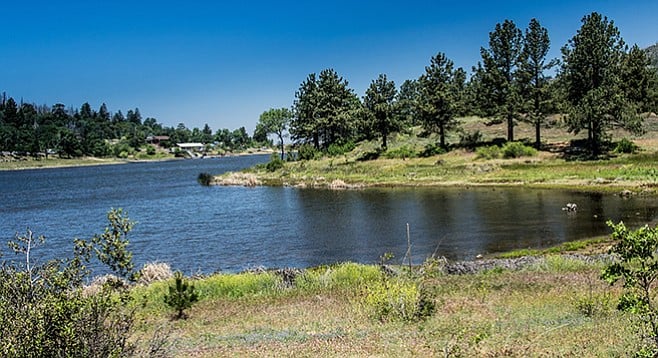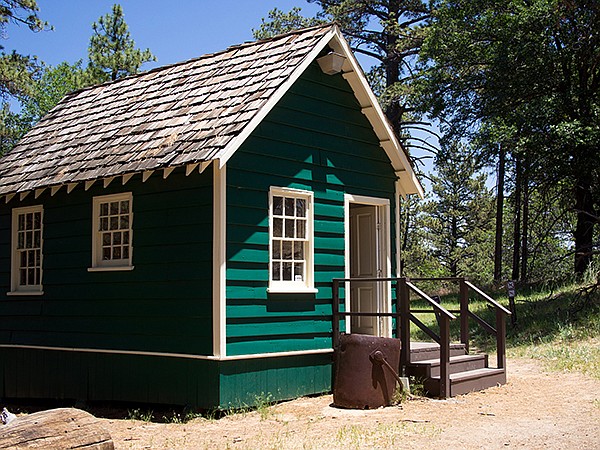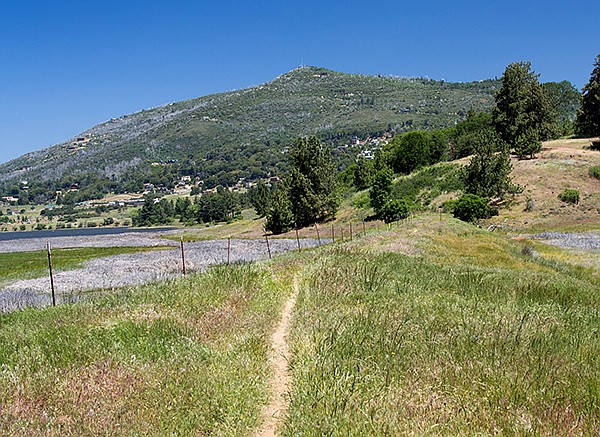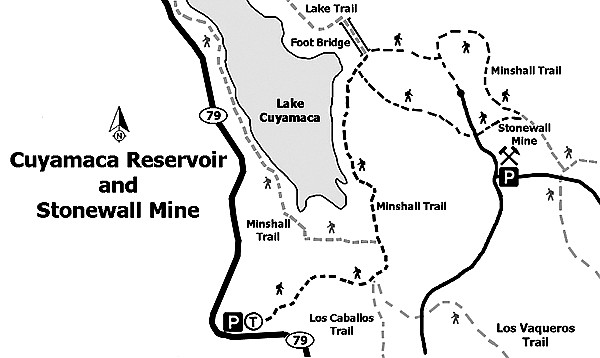 Facebook
Facebook
 X
X
 Instagram
Instagram
 TikTok
TikTok
 Youtube
Youtube

Unlike most of Cuyamaca Rancho State Park, the trees that enhanced the beauty of this park were not heavily damaged or destroyed on the peninsula in Lake Cuyamaca by the 2003 Cedar Fire. As a result, this area is a reminder of the past glory of the Cuyamaca Mountains. Additionally, the area is steeped in history. It was in the early 1870s that gold was first discovered in the Julian area, sparking a gold rush that lasted over 20 years. One of the most productive mines of the area was in the Cuyamaca Mountains. Cuyamaca Lake is a reservoir whose waters were impounded by a dam built in 1887 to supply San Diego with the water essential for its subsequent rapid growth. Although no longer San Diego’s water source, it now is important for the recreation it provides, including fishing, boating, and camping, in addition to hiking.

From the parking area, take the Trout Pond Trail east through a marsh, crossing two small streams, and walk past a small puddle that could be the “Trout Pond,” though it is unlikely that trout lived here. Once out of the marsh, the trail curves north and passes through grassland at the base of a hill. In 0.4 mile there is a signed junction of the Los Caballos/Los Vaqueros Trails on the right and the Minshall Trail straight ahead. Continue straight ahead on the Minshall Trail. This trail follows the lake’s former shoreline around a peninsula that at one time was surrounded on three sides by water. With the recent drought, much of what was once water is now marsh or grassland. If visiting in the spring, look for wildflowers that bloom in abundance in the grasslands. These include checkerbloom, wild flax, wine cup clarkia, California thistle, and many others.
In another 0.1 mile, the trail crosses a causeway that currently has grassland on both sides, although water can be seen to the northwest. The land beyond the causeway is more heavily forested and eventually follows the contours of the lake, but slightly above it. The most abundant trees are black oaks and Jeffery pines, but there is also an understory with numerous tree-like blue elderberry and choke cherry bushes.
About one mile into the hike, look for a bridge on the left leading to Fletcher Island. It is an island only in El Niño years when the water level is much higher; now it is a peninsula. Access to the bridge and island is blocked by a fence. Continue straight ahead on the Minshall Trail. Shortly you pass the Stonewall Mine Trail on your right. For now continue ahead on Minshall where expansive views of grassland and meadows open up to the northeast, extending to the Sunrise Highway and southeast to the Soapstone Grade.
The Minshall Trail is named for Margaret Minshall, who owned a ranch between the horse camp and the Stonewall Mine. She was a dedicated park volunteer who donated land not only to Cuyamaca Rancho State Park but also to Oakoasis Preserve.

Soon there will be another fence and a trail branching off to the right that leads to the Stonewall Mine. Gold was discovered here in a quartz outcrop in 1870 and the rush was on. A hard rock mineshaft once went over 600 feet down into the earth, from which $2 million of gold was extracted (in 1880 dollars; current value would be about $67 million). A company town grew up here and housed about 500 workers at its peak. Not much remains today other than a number of mining artifacts. There is a small museum in a separate building that tells much of the mine’s history. It is definitely worth a visit.

It should also be mentioned that the Stonewall Mine site can be reached by car from SR-79, making it accessible to non-hikers. There is a parking lot and restroom facilities here for mine visitors.
After exploring the mine, walk down the paved road to the north, past a service area, and find a trail leading down to an equestrian picnic area. Though not signed at this end, it connects with the Minshall Trail beyond the picnic area. Turn left on the Minshall and follow it back to your vehicle.
While the best time to visit the area is late March through June when wildflowers are in bloom, other times have something to offer throughout the year. The black oaks can provide a splash of color in autumn and there may be snow in winter.
Distance from downtown San Diego: 52 miles. Allow one hour driving time (Lake Cuyamaca). Take I-8 E and exit on SR-79/Japatul Valley Rd. Drive north on SR-79, 13.4 miles to where SR-79 takes a 90-degree turn. The parking area and trailhead is on the right side before the turn.
Hiking length: 2.7 miles out-and-back with a small loop.
Difficulty: Easy, with about 300 feet of elevation gain/loss. Facilities and water near the mine. The trails are all well-marked and maintained. Involves crossing a muddy marsh. Dogs and bicycles not allowed.


Unlike most of Cuyamaca Rancho State Park, the trees that enhanced the beauty of this park were not heavily damaged or destroyed on the peninsula in Lake Cuyamaca by the 2003 Cedar Fire. As a result, this area is a reminder of the past glory of the Cuyamaca Mountains. Additionally, the area is steeped in history. It was in the early 1870s that gold was first discovered in the Julian area, sparking a gold rush that lasted over 20 years. One of the most productive mines of the area was in the Cuyamaca Mountains. Cuyamaca Lake is a reservoir whose waters were impounded by a dam built in 1887 to supply San Diego with the water essential for its subsequent rapid growth. Although no longer San Diego’s water source, it now is important for the recreation it provides, including fishing, boating, and camping, in addition to hiking.

From the parking area, take the Trout Pond Trail east through a marsh, crossing two small streams, and walk past a small puddle that could be the “Trout Pond,” though it is unlikely that trout lived here. Once out of the marsh, the trail curves north and passes through grassland at the base of a hill. In 0.4 mile there is a signed junction of the Los Caballos/Los Vaqueros Trails on the right and the Minshall Trail straight ahead. Continue straight ahead on the Minshall Trail. This trail follows the lake’s former shoreline around a peninsula that at one time was surrounded on three sides by water. With the recent drought, much of what was once water is now marsh or grassland. If visiting in the spring, look for wildflowers that bloom in abundance in the grasslands. These include checkerbloom, wild flax, wine cup clarkia, California thistle, and many others.
In another 0.1 mile, the trail crosses a causeway that currently has grassland on both sides, although water can be seen to the northwest. The land beyond the causeway is more heavily forested and eventually follows the contours of the lake, but slightly above it. The most abundant trees are black oaks and Jeffery pines, but there is also an understory with numerous tree-like blue elderberry and choke cherry bushes.
About one mile into the hike, look for a bridge on the left leading to Fletcher Island. It is an island only in El Niño years when the water level is much higher; now it is a peninsula. Access to the bridge and island is blocked by a fence. Continue straight ahead on the Minshall Trail. Shortly you pass the Stonewall Mine Trail on your right. For now continue ahead on Minshall where expansive views of grassland and meadows open up to the northeast, extending to the Sunrise Highway and southeast to the Soapstone Grade.
The Minshall Trail is named for Margaret Minshall, who owned a ranch between the horse camp and the Stonewall Mine. She was a dedicated park volunteer who donated land not only to Cuyamaca Rancho State Park but also to Oakoasis Preserve.

Soon there will be another fence and a trail branching off to the right that leads to the Stonewall Mine. Gold was discovered here in a quartz outcrop in 1870 and the rush was on. A hard rock mineshaft once went over 600 feet down into the earth, from which $2 million of gold was extracted (in 1880 dollars; current value would be about $67 million). A company town grew up here and housed about 500 workers at its peak. Not much remains today other than a number of mining artifacts. There is a small museum in a separate building that tells much of the mine’s history. It is definitely worth a visit.

It should also be mentioned that the Stonewall Mine site can be reached by car from SR-79, making it accessible to non-hikers. There is a parking lot and restroom facilities here for mine visitors.
After exploring the mine, walk down the paved road to the north, past a service area, and find a trail leading down to an equestrian picnic area. Though not signed at this end, it connects with the Minshall Trail beyond the picnic area. Turn left on the Minshall and follow it back to your vehicle.
While the best time to visit the area is late March through June when wildflowers are in bloom, other times have something to offer throughout the year. The black oaks can provide a splash of color in autumn and there may be snow in winter.
Distance from downtown San Diego: 52 miles. Allow one hour driving time (Lake Cuyamaca). Take I-8 E and exit on SR-79/Japatul Valley Rd. Drive north on SR-79, 13.4 miles to where SR-79 takes a 90-degree turn. The parking area and trailhead is on the right side before the turn.
Hiking length: 2.7 miles out-and-back with a small loop.
Difficulty: Easy, with about 300 feet of elevation gain/loss. Facilities and water near the mine. The trails are all well-marked and maintained. Involves crossing a muddy marsh. Dogs and bicycles not allowed.
Comments